Inside the Taj Mahal: A World of Beauty
Stepping inside the Taj Mahal is akin to entering a realm of exquisite beauty, where every detail reflects the deep love that inspired its creation. This architectural marvel, built in memory of Mumtaz Mahal by her husband, Emperor Shah Jahan, is not just a mausoleum but a testament to the artistry and dedication of the craftsmen who brought this dream to life.
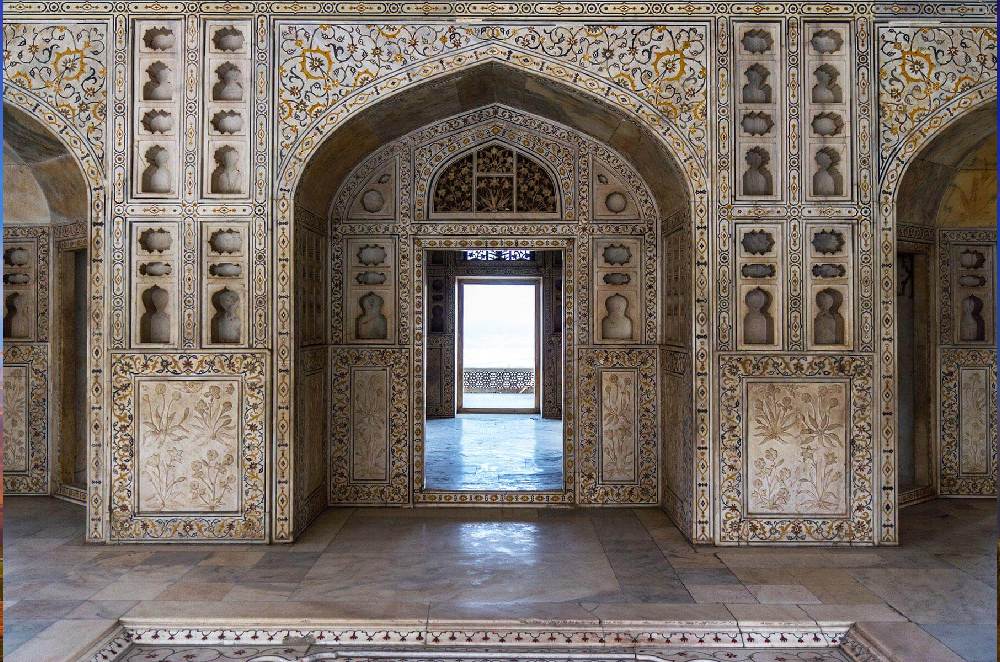
The Interior of the Taj Mahal
Upon entering the Taj Mahal, visitors are immediately captivated by the intricate marble inlay work that adorns its walls and ceilings. The stunning craftsmanship features delicate floral designs and elaborate calligraphy, each element carefully placed to create a harmonious whole. The technique, known as pietra dura, involves embedding precious and semi-precious stones into the white marble, resulting in breathtaking patterns that seem to come alive in the light.
The central chamber of the Taj Mahal is the heart of this magnificent structure. It houses the cenotaphs of Shah Jahan and Mumtaz Mahal, both adorned with intricate carvings and inlays. These cenotaphs are not the actual tombs; the real graves lie in a lower chamber, where visitors cannot enter. The serene ambiance of the central chamber, with its soaring domes and ethereal light, evokes a sense of peace and reverence, leaving visitors in awe of the craftsmanship that has stood the test of time.
As you walk through the interior, the play of light and shadow enhances the experience, creating a spiritual atmosphere that invites contemplation. The exquisite symmetry and elegant design of the Taj Mahal demonstrate the pinnacle of Mughal architecture, making it a site that resonates with beauty and artistry.
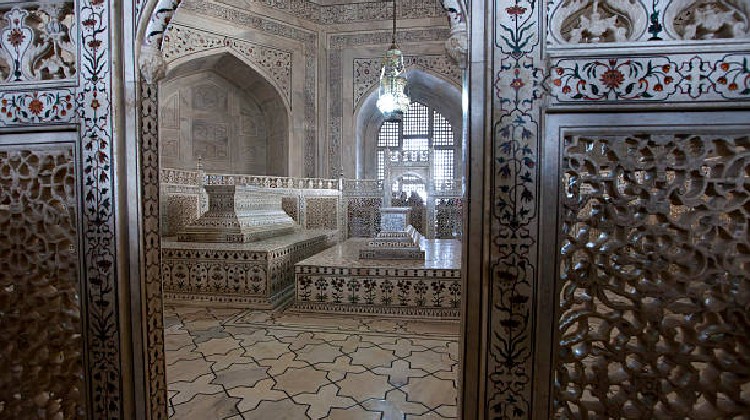
Agra Taj Mahal: A Symbol of Love
The Taj Mahal in Agra is much more than an architectural wonder; it is a powerful symbol of eternal love. Built in the 17th century, this magnificent structure was commissioned by Shah Jahan as a tribute to his beloved wife, Mumtaz Mahal, who died during childbirth. Their love story, marked by devotion and tragedy, has become legendary.
Construction of the Taj Mahal began in 1632 and was completed in 1653, involving the labor of thousands of artisans, architects, and craftsmen from across the Mughal Empire and beyond. The project employed innovative techniques and meticulous planning, resulting in a structure that has captured the hearts of millions. The Taj Mahal stands not only as a testament to Shah Jahan’s love but also to the incredible artistry and architectural prowess of the Mughal era.
Every aspect of the Taj Mahal was carefully designed to reflect this love. The choice of materials, the intricate details, and the overall grandeur of the structure all speak to a deep emotional connection. This makes the Taj Mahal a timeless symbol, resonating with anyone who visits, regardless of their background.
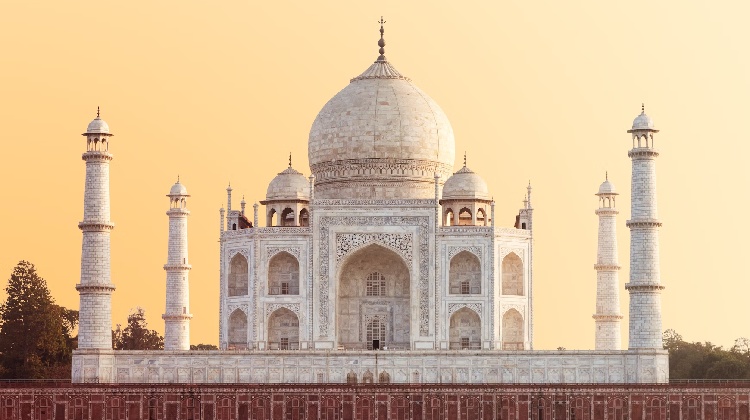
Taj Mahal History: A Glimpse into the Past
The history of the Taj Mahal is as captivating as its stunning architecture. The Mughal Empire, known for its grandiose architectural projects, reached its zenith during the reign of Shah Jahan. The construction of the Taj Mahal occurred during a period of great prosperity and cultural flourishing, a time when art, literature, and architecture thrived.
The Taj Mahal is an exceptional example of Mughal architecture, combining elements from Persian, Islamic, and Indian styles. The use of symmetry, geometric patterns, and intricate detailing reflects the influence of Persian design, while the incorporation of local materials and motifs showcases Indian artistic traditions. This fusion of styles results in a unique masterpiece that has stood the test of time, captivating visitors from around the world.
The historical context of the Taj Mahal is equally significant. Built in an era marked by political stability and economic prosperity, the Taj Mahal symbolizes not just love but also the zenith of Mughal cultural achievements. It represents the legacy of a dynasty that left an indelible mark on India’s architectural landscape.
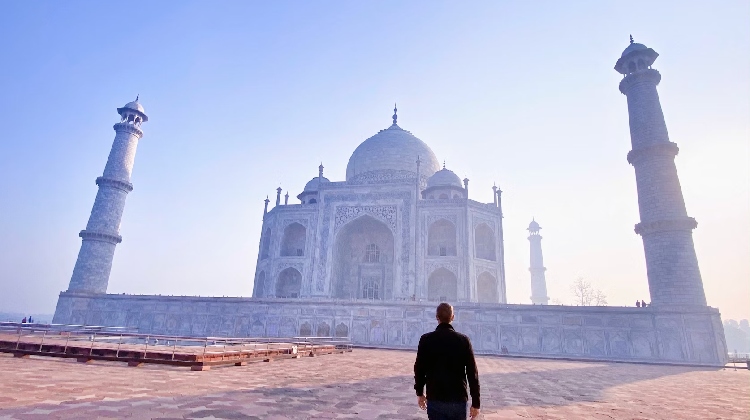
Taj Mahal Garden: A Paradise on Earth
Enveloping the iconic Taj Mahal is the exquisite Charbagh garden, a breathtaking example of Persian design that embodies the concept of paradise as envisioned in Islamic tradition. This meticulously planned garden is divided into four distinct quadrants by a series of elegant walkways and serene water channels, creating a harmonious symmetry that draws visitors into its tranquil embrace. Each quadrant symbolizes a different aspect of paradise: one may feature lush green lawns filled with vibrant flowers, while another might showcase reflective pools that capture the sky’s colors, enhancing the garden’s ethereal beauty.
As you wander through the garden, you are greeted by the gentle sound of water flowing from intricately designed fountains, their rhythmic splashes adding to the soothing ambiance. The air is filled with the sweet fragrances of blooming flowers, creating an immersive sensory experience that invites introspection and appreciation for the natural beauty surrounding the majestic mausoleum. This serene environment offers perfect spots for contemplation, allowing visitors to pause and absorb the grandeur of the Taj Mahal before them.
The garden’s symmetry and thoughtful layout not only elevate the aesthetic appeal of the Taj Mahal but also serve to guide the visitor’s gaze toward the mausoleum itself, which stands resplendent at the garden’s center. The interplay of nature and architecture reflects the Mughal Empire’s deep respect for gardens as sanctuaries of peace and beauty. The Charbagh garden is not merely a picturesque backdrop; it symbolizes the profound connection between the natural world and human creation, enhancing the overall experience of visiting this UNESCO World Heritage Site. Every element, from the carefully arranged plants to the reflective water features, contributes to an environment that celebrates the splendor of life and love, making the Taj Mahal a true paradise on Earth.
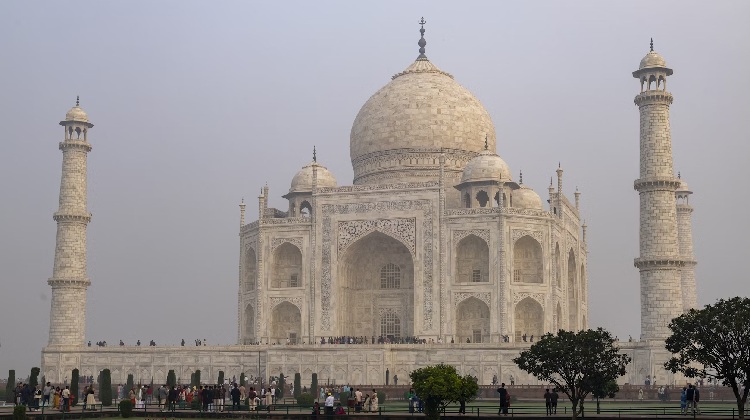
Taj Mahal Attraction: More Than Just a Monument
The Taj Mahal is not merely its main building; it offers a rich experience through the various structures surrounding it. Visitors can explore the mosque and the guest house, both crafted from red sandstone. These buildings not only provide functional spaces for prayer and rest but also add to the visual splendor of the complex.
The main gateway, known as the Darwaza-i-rauza, is another remarkable feature of the Taj Mahal. This grand entrance, adorned with intricate carvings and inscriptions, sets the tone for the beauty that lies beyond. It serves as a transition from the bustling outside world to the serene environment of the gardens and the mausoleum.
Each component of the Taj Mahal complex contributes to its allure and grandeur, providing visitors with a comprehensive experience. From the stunning architecture to the surrounding gardens, every detail has been meticulously planned to create a cohesive and enchanting atmosphere.
The Influence of the Taj Mahal on Culture
Over the centuries, the Taj Mahal has inspired countless artists, poets, and writers. Its image has become synonymous with love and beauty, often depicted in literature and art. This enduring influence reflects the emotional connection that people have with the monument, transcending time and cultural boundaries.
The architectural style of the Taj Mahal has also left a lasting impact on structures around the world. Its design principles and aesthetic elements have been emulated in various buildings, making it a benchmark for beauty and elegance in architecture. The Taj Mahal’s designation as a UNESCO World Heritage Site in 1983 further solidified its status as a global cultural treasure, ensuring its preservation for future generations.
The Taj Mahal attracts millions of tourists each year, making it a vital contributor to the local economy. The surrounding communities, including artisans, guides, and vendors, benefit significantly from the influx of visitors, highlighting the monument’s importance not only as a historical site but also as a source of livelihood.
Tips for Visiting the Taj Mahal
To make the most of your visit to the Taj Mahal, it is helpful to plan ahead. Purchasing tickets in advance can save time, especially during peak tourist seasons. The Taj Mahal is open from sunrise to sunset, and many visitors prefer to arrive early in the morning or later in the afternoon to avoid crowds and enjoy optimal lighting for photography.
Dressing appropriately is also essential, as the Taj Mahal is a revered site. Visitors should wear modest clothing and be prepared to remove their shoes before entering the mausoleum. Comfortable footwear is advisable, as exploring the extensive grounds can involve a fair amount of walking.
Bringing water and snacks is a good idea, as the complex can be quite large, and options for food may be limited and expensive. A camera is a must, as the stunning architecture and beautiful gardens offer countless opportunities for unforgettable photos.
Conclusion: The Timeless Allure of the Taj Mahal
In conclusion, the Taj Mahal is a timeless symbol of love, beauty, and architectural brilliance. From its intricate interiors and lush gardens to its rich history and cultural significance, the Taj Mahal in Agra is a must-visit attraction. Whether you are a history enthusiast, an architecture lover, or simply a traveler seeking to witness one of the world’s greatest wonders, the Taj Mahal promises an unforgettable experience.
This magnificent monument continues to capture the hearts of all who visit, offering a glimpse into the depths of love and artistry that inspired its creation. The Taj Mahal stands not only as a memorial to a beloved wife but also as a universal symbol of the enduring nature of love, reminding us of the power of devotion across generations.


